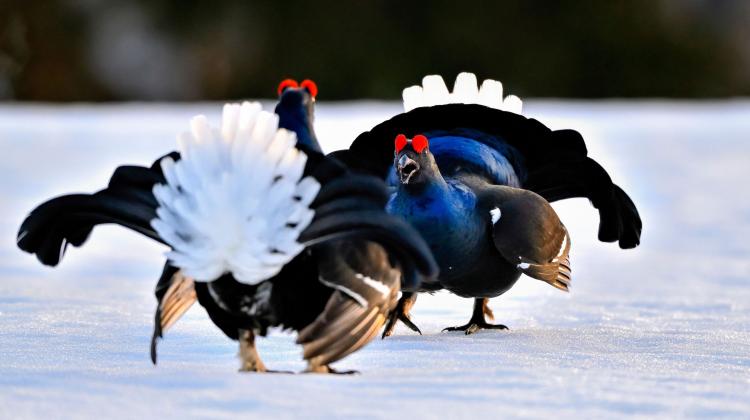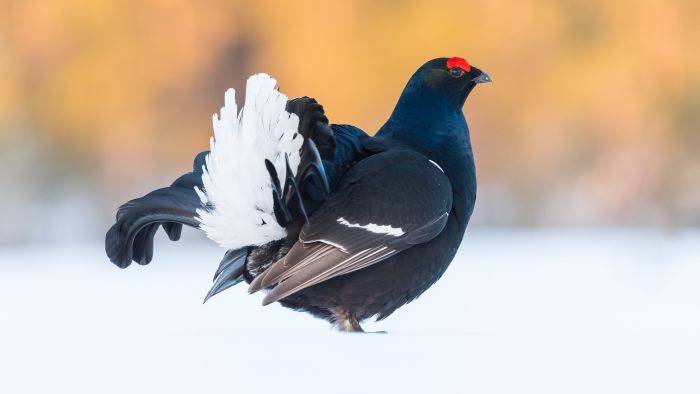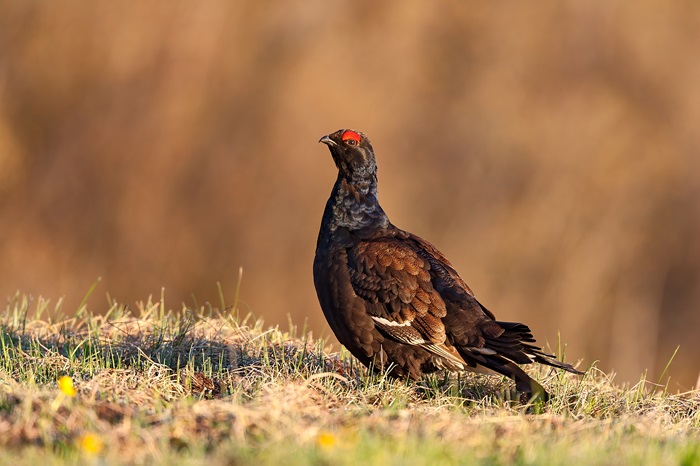Black grouse population in Poland nearly extinct, warns biologist
 Credit: Adobe Stock
Credit: Adobe Stock
The black grouse population in Poland is on the verge of extinction, says Michał Adamowicz from the Faculty of Biology at the University of Warsaw. Over a few decades, it decreased from 30,000 to less than 300. The reasons include climate warming, the influx of alien species resulting mainly from human activity, and landscape changes for agricultural areas.
Despite the progress of civilization, the Tatra Mountains are an important refuge for many species of plants and animals, including black grouse. A comparison of the numbers and situation of birds living in the mountains with the populations living in the Biebrza Valley shows that the mountains remain the places that are most difficult for humans to 'spoil'. Therefore, black grouses have the greatest chance of survival in the mountains.
As part of Adamowicz’s doctoral project, he is carrying out research on 'Threats and chances of survival of the black grouse (Lyrurus tetrix) populations in two types of environments: mountain environments on the example of the Tatra Mountains and lowland environments on the example of the Biebrza Valley'.

The black grouse population, especially in Central and Western Europe, is declining and slowly dying out. The southwestern border of the continuous range of this species is located in Poland,’ Adamowicz tells PAP.
'However, my earlier (master's thesis) and current (doctoral) research indicate a clearly slower rate of disappearance of mountain populations (in the Sudetes and the Tatra Mountains) than lowland populations (in Masuria, the Biebrza Valley, the Orawa-Nowy Targ Valley)'.
Why does that happen?
Threat No. 1: Climate change
'It is clear at first glance that the black grouse populations are larger in northern and north-eastern Europe: in Scandinavia, Siberia, Belarus and Estonia. The further south and west we move, the less numerous its populations become or even become extinct,’ Adamowicz says.
He adds: 'Until recently there was no such difference. The conclusion that comes to mind is that climate change is responsible. A different temperature distribution than 30 years ago and a different landscape shape deprive the black grouse of its habitats and food base. It is also becoming more accessible to a larger number of predators, including those that have increased their numbers due to global warming, and those that are invasive species'.
Threat No. 2: Habitat transformation
In addition to global warming, human activity is of great importance for the black grouse, as it has transformed almost all of this bird's habitats.
'Black grouse is a sedentary birds, which means it does not migrate for the winter. However, at different times of the year, for example during the breeding, mating and wintering periods, these birds prefer different types of habitats. They always need a mosaic of open, semi-open and overgrown areas. Such places are located, for example, in wetland river valleys, where the groundwater level is high, so lush vegetation does not grow there. Good conditions for black grouse also exist on moors, where low shrubs and blueberries dominate, not thickets,’ says Adamowicz.
However, the drainage of wetlands that has been observed for years, the mechanical transformation of agriculture, and a different method of managing fields, in which no trees are left in the vicinity of forests - all this has caused this species to lose most of its habitats in Poland. 'And climate change is fuelling this even more. What was unthinkable several dozen years ago, e.g. droughts and fires in the Biebrza Valley, now happens almost every year. And a drying swamp quickly overgrows and what I mentioned earlier - happens,’ says Adamowicz.
Threat No. 3: Invasive predators
Another factor contributing to the dramatic situation of the black grouse is the increasing number of predators that prey on the species. According to Adamowicz, two factors may be responsible for this increase. The first is the mass vaccination of foxes against rabies.
'There is little talk about it, but vaccinations caused the fox population in our country to increase 3-4 times. And foxes eat the eggs of birds nesting on the ground, including black grouses.’
In addition, recently more and more alien species have been arriving and wreaking havoc on native nature. The phenomenon of increased predation on black grouse is also driven by global warming, which has turned previously inhabitable areas into more favourable living conditions: for example, drying wetlands are much easier for predators to penetrate than heavily swampy areas.
'When raccoon dogs reached the Biebrza Valley, the number of foxes also increased significantly, and droughts in the swamps became an everyday occurrence; predators have simply become the nail in the coffin,’ Adamowicz says.
Threat No. 4: Hunting
Until 1995, black grouse was a game bird in Poland, which also significantly thinned the population.
'In Finland and Norway, black grouse is doing better due to the colder climate. So much so that hunting them is still allowed there. It is a paradox: in some countries, so much energy and money is spent on saving habitats and releasing farmed birds into the environment, while in others they are freely hunted,’ Adamowicz says.
Mountains are harder for us to spoil
The above-mentioned mosaic of open, semi-open and overgrown areas, necessary for the life of black grouses, also occurs in the mountains, near the upper edge of the forest. These are places where Tatra black grouses live. 'Mountains, understandably, are more difficult for humans to transform, i.e. destroy, so black grouses have much better conditions there. They like to live in places that have been transformed by invertebrate outbreaks, as well as by fires or even acid rains and storms. That is, where there is a gap in the forest and a specific mosaic forms,’ Adamowicz.

Therefore, in his opinion, the species has a chance to survive in the mountains for a while, unless tourist pressure becomes even stronger. 'Nowadays, this is a huge problem even in National Parks. A particular threat is off-piste skiing, which is becoming more common,’ he says.
Save the black grouse
According to Adamowicz, the key to protecting the black grouse is to talk about it, show it to people, and educate them.
'Various projects are being carried out to support the black grouse population. For example, attempts are being made to thin out birch trees in wet meadows to create favourable conditions for these birds. However, with ongoing changes in the landscape, drainage of areas and global warming, this is very difficult,’ he says.
There are also attempts to introduce birds from breeding farms into the natural environment. However, in the case of the black grouse, this is an extremely difficult task. 'Birds released into the environment must be able to live independently in the wild. They must be afraid of all predators, as well as people. It would be optimal to breed them from the beginning so that they are afraid of humans. However, any contact with such animals in the aviary could be dangerous for them. In turn, if birds become too accustomed to the presence of people, they will not be vigilant enough in the wild,’ says Adamowicz.
While collecting materials for his research, he and Filip Chudzyński, made a film titled Kohut, which was not only a documentation of the researcher's work. ’It is a story about how a person's approach changes: from setting a goal and attempting to achieve it, to appreciating the very experience of nature,’ the biologist says.
The film was presented at over 30 screenings with authors' meetings in various Polish cities. For a few days now, it has also been available online at filmygorskie.pl.
Adamowicz is also involved in the educational campaign Chronić Cię Trzeba ('You Need to be Protected'). This Tatra National Park campaign is aimed at educating people to practice tourism and mountain sports responsibly and with respect for nature. They should stick to hiking trails and ski scarves, refrain from entering the Park at night during periods when it is not allowed, littering, and from making noise.
'There are several places in Poland that are completely unique in terms of nature. These include the Białowieża Forest, the Biebrza Valley and the Tatra Mountains. However, while most people go to the Białowieża Forest and Biebrza to admire and observe nature, they do not necessarily go to the mountains for these reasons. Of course, there are enthusiasts on the Tatra trails, but a surprisingly large number of tourists are not interested in nature. And at this scale, it creates problems. Our campaign is not only about punishing people with fines, but also about showing people the beauty of nature and getting them interested in it through art, photography, films and music,’ says Adamowicz.
He adds: ’It's hard to protect something we don't know anything about. We can only protect species such as the black grouse by better understanding them and observing them in these last European refuges. My research is intended to serve this purpose: to show their attachment to specific plant clusters and specific landforms.'
PAP - Science in Poland, Katarzyna Czechowicz
kap/ agt/
tr. RL
Przed dodaniem komentarza prosimy o zapoznanie z Regulaminem forum serwisu Nauka w Polsce.


















